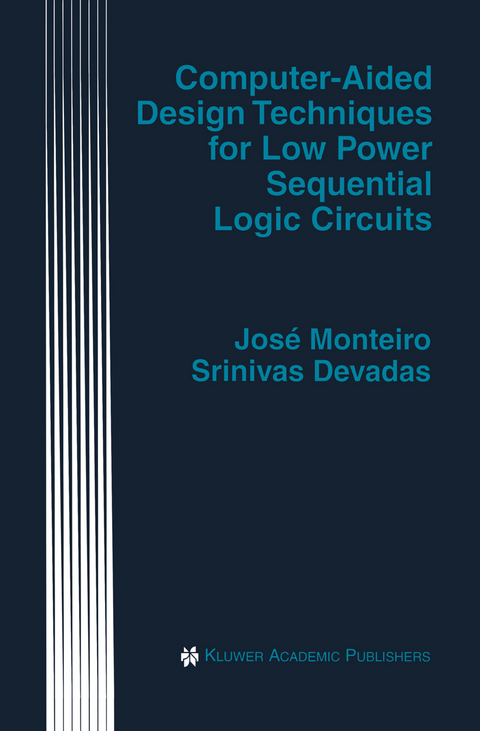
Computer-Aided Design Techniques for Low Power Sequential Logic Circuits
Springer-Verlag New York Inc.
978-1-4613-7901-0 (ISBN)
Computer-Aided Design Techniques for Low Power Sequential Logic Circuits presents a methodology for low power design. The authors first present a survey of techniques for estimating the average power dissipation of a logic circuit. At the logic level, power dissipation is directly related to average switching activity. A symbolic simulation method that accurately computes the average switching activity in logic circuits is then described. This method is extended to handle sequential logic circuits by modeling correlation in time and by calculating the probabilities of present state lines.
Computer-Aided Design Techniques for Low Power Sequential Logic Circuits then presents a survey of methods to optimize logic circuits for low power dissipation which target reduced switching activity. A method to retime a sequential logic circuit where registers are repositioned such that the overall glitching in the circuit is minimized is also described. The authors then detail a powerful optimization method that is based on selectively precomputing the output logic values of a circuit one clock cycle before they are required, and using the precomputed value to reduce internal switching activity in the succeeding clock cycle.
Presented next is a survey of methods that reduce switching activity in circuits described at the register-transfer and behavioral levels. Also described is a scheduling algorithm that reduces power dissipation by maximising the inactivity period of the modules in a given circuit.
Computer-Aided Design Techniques for Low Power Sequential Logic Circuits concludes with a summary and directions for future research.
1 Introduction.- 1.1 Power as a Design Constraint.- 1.2 Organization of this Book.- References.- 2 Power Estimation.- 2.1 Power Dissipation Model.- 2.2 Switching Activity Estimation.- 2.3 Summary.- References.- 3 A Power Estimation Method for Combinational Circuits.- 3.1 Symbolic Simulation.- 3.2 Transparent Latches.- 3.3 Modeling Inertial Delay.- 3.4 Power Estimation Results.- 3.5 Summary.- References.- 4 Power Estimation for Sequential Circuits.- 4.1 Pipelines.- 4.2 Finite State Machines: Exact Method.- 4.3 Finite State Machines: Approximate Method.- 4.4 Results on Sequential Power Estimation Techniques.- 4.5 Modeling Correlation of Input Sequences.- 4.6 Summary.- References.- 5 Optimization Techniques for Low Power Circuits.- 5.1 Power Optimization by Transistor Sizing.- 5.2 Combinational Logic Level Optimization.- 5.3 Sequential Optimization.- 5.4 Summary.- References.- 6 Retiming for Low Power.- 6.1 Review of Retiming.- 6.2 Retiming for Low Power.- 6.3 Experimental Results.- 6.4 Conclusions.- References.- 7 Precomputation.- 7.1 Subset Input Disabling Precomputation.- 7.2 Complete Input Disabling Precomputation.- 7.3 Combinational Precomputation.- 7.4 Multiplexor-Based Precomputation.- 7.5 Conclusions.- References.- 8 High-Level Power Estimation and Optimization.- 8.1 Register Transfer Level Power Estimation.- 8.2 Behavioral Level Synthesis for Low Power.- 8.3 Conclusions.- References.- 9 Conclusion.- 9.1 Power Estimation at the Logic Level.- 9.2 Optimization Techniques at the Logic Level.- 9.3 Estimation and Optimization Techniques at the RT Level.- References.
| Erscheint lt. Verlag | 12.10.2012 |
|---|---|
| Reihe/Serie | The Springer International Series in Engineering and Computer Science ; 387 |
| Zusatzinfo | XVII, 181 p. |
| Verlagsort | New York, NY |
| Sprache | englisch |
| Maße | 155 x 235 mm |
| Themenwelt | Sachbuch/Ratgeber ► Natur / Technik ► Garten |
| Mathematik / Informatik ► Informatik ► Theorie / Studium | |
| Informatik ► Weitere Themen ► CAD-Programme | |
| Technik ► Elektrotechnik / Energietechnik | |
| ISBN-10 | 1-4613-7901-6 / 1461379016 |
| ISBN-13 | 978-1-4613-7901-0 / 9781461379010 |
| Zustand | Neuware |
| Haben Sie eine Frage zum Produkt? |
aus dem Bereich


